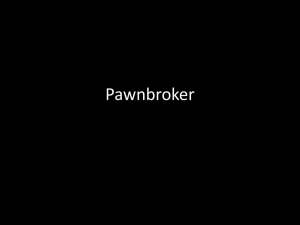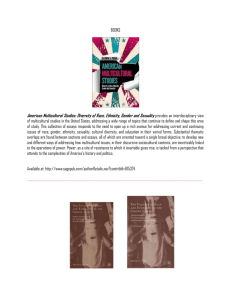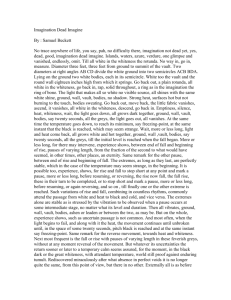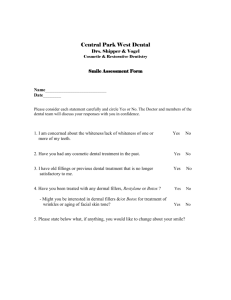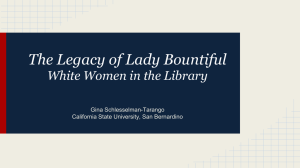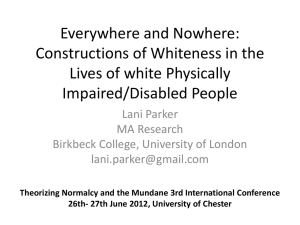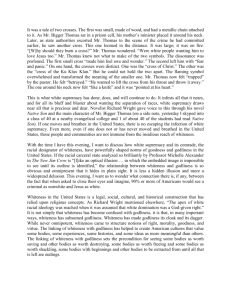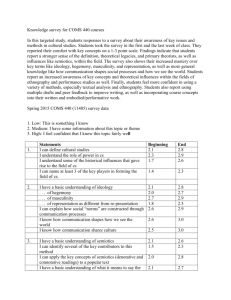BUILDING THE WORLD WE DREAM ABOUT A Tapestry of Faith
advertisement
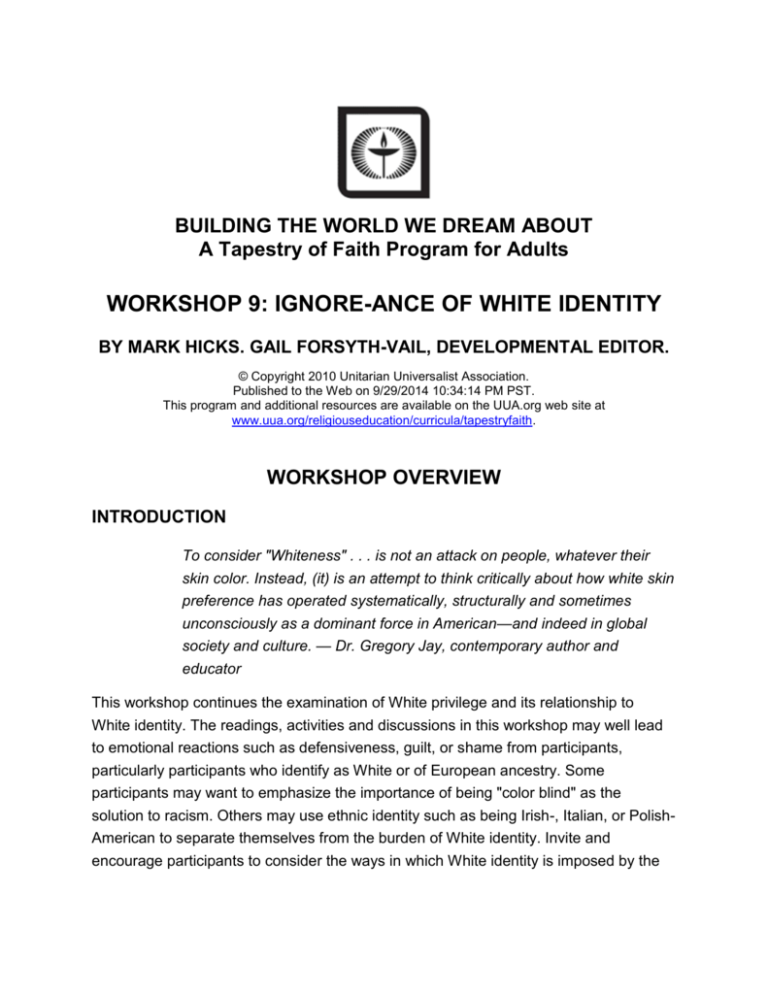
BUILDING THE WORLD WE DREAM ABOUT A Tapestry of Faith Program for Adults WORKSHOP 9: IGNORE-ANCE OF WHITE IDENTITY BY MARK HICKS. GAIL FORSYTH-VAIL, DEVELOPMENTAL EDITOR. © Copyright 2010 Unitarian Universalist Association. Published to the Web on 9/29/2014 10:34:14 PM PST. This program and additional resources are available on the UUA.org web site at www.uua.org/religiouseducation/curricula/tapestryfaith. WORKSHOP OVERVIEW INTRODUCTION To consider "Whiteness" . . . is not an attack on people, whatever their skin color. Instead, (it) is an attempt to think critically about how white skin preference has operated systematically, structurally and sometimes unconsciously as a dominant force in American—and indeed in global society and culture. — Dr. Gregory Jay, contemporary author and educator This workshop continues the examination of White privilege and its relationship to White identity. The readings, activities and discussions in this workshop may well lead to emotional reactions such as defensiveness, guilt, or shame from participants, particularly participants who identify as White or of European ancestry. Some participants may want to emphasize the importance of being "color blind" as the solution to racism. Others may use ethnic identity such as being Irish-, Italian, or PolishAmerican to separate themselves from the burden of White identity. Invite and encourage participants to consider the ways in which White identity is imposed by the larger society. Ask: how does White privilege apply even for White people who don't think of themselves as White? Before leading this workshop, review the accessibility guidelines in the program Introduction under Integrating All Participants. GOALS This workshop will: Introduce the concepts of White identity and "Whiteness" Provide a variety of activities and conversations that deepen participants' understanding of Whiteness and its impact on their day-to-day lives. LEARNING OBJECTIVES Participants will: Define Whiteness and White identity Gain knowledge and understanding of how Whiteness is normalized in their dayto-day lives and in the culture at large. WORKSHOP-AT-A-GLANCE Activity Minutes Welcoming and Entering 0 Opening 10 Activity 1: Putting "White" on the Table 15 Activity 2: Discovering Whiteness 35 Activity 3: Whiteness Defined 15 Activity 4: Serial Testimony 35 Closing 10 Alternate Activity 1: Exploring Race in Film 20 SPIRITUAL PREPARATION If you are a White person, meditate or journal about how you discovered your "whiteness." What role has Whiteness played in your life? If you are a Person of Color or from a group marginalized by race or ethnicity, how did you learn about "Whiteness?" How has Whiteness impacted your life? WORKSHOP PLAN WELCOMING AND ENTERING Materials for Activity Sign-in sheet and pen or pencil Name tags for participants (durable or single-use) and bold markers Optional: Music and player Optional: Snacks and beverages Preparation for Activity Arrange chairs in a circle and set out name tags and markers on a table. Optional: Play music softly in the background. Optional: Set out snacks and beverages. Description of Activity Greet participants as they arrive. OPENING (10 MINUTES) Preparation for Activity Practice reading the chalice lighting aloud. Review participant evaluations from the previous workshop. Discuss with your co-facilitators any patterns or concerns that have emerged. Prepare to briefly share feedback with the group, while keeping confidentiality. Description of Activity Light the chalice or invite a participant to light it while you read these words from Harlon Dalton: Why do most White people not see themselves as having a race? In part, race obliviousness is the natural consequence of being in the driver's seat. We are all much more likely to disregard attributes that seldom produce a ripple than we are those that subject us to discomfort. For example, a Reform Jewish family living in, say, Nacogdoches, Texas, will be more acutely aware of its religious/ethnic heritage than will the Baptist family next door. On the other hand, if that same family moved to the Upper West Side of Manhattan, its Jewishness would probably be worn more comfortably. For most Whites, race—or more precisely, their own race—is simply part of the unseen, unproblematic background. Share feedback from the previous workshop evaluations. Acknowledge shared patterns and observations to give participants a sense of how people in the group are thinking and feeling about the program. Be conscientious about maintaining confidentiality. One technique is to say, "Some people felt... .," rather than saying "One of you felt... .". If time allows, invite participants to share one-minute observations or new insights they may have gained since the last workshop. Remind participants of the spirit of their covenant. Share the goals of this workshop. ACTIVITY 1: PUTTING "WHITE" ON THE TABLE (15 MINUTES) Materials for Activity Leader Resource 1, Putting "White" on the Table (included in this document) Preparation for Activity Print Leader Resource 1 and familiarize yourself with it. Description of Activity Read the statements in Leader Resource 1, pairing the statement in the left-hand column with the statement in the right-hand column. Invite participants to monitor their feelings and thoughts as they listen to the statements. Lead a large group discussion with these questions: What feelings emerged for you as you heard the list? Why do you think the mention of "Whiteness" changed the sentence? How would your reaction be different if the word "Asian" or "Latino/a" were substituted for "White" in the sentences"? ACTIVITY 2: DISCOVERING WHITENESS (35 MINUTES) Materials for Activity Handout 1, Discovering Whiteness (included in this document) Newsprint, markers, and tape Preparation for Activity Copy Handout 1 for all participants. Description of Activity Distribute and read aloud Handout 1, explaining that it is a first person narrative. Invite comments, insights, and observations. Lead a discussion, using these questions as guides: What elements of Gary Howard's story help you get a better understanding of a "White identity"? How might Gary Howard's experiences, which took place in the 1950s, be different today? How might they be the same? Post a piece of newsprint and title it "White Identity." Invite participants to brainstorm answers to the question, How would you describe a "White identity"? Explain that in a brainstorm, all suggestions and ideas voiced are captured on newsprint with commentary or discussion. ACTIVITY 3: WHITENESS DEFINED (15 MINUTES) Materials for Activity Handout 2, Whiteness Defined (included in this document) Brainstorming list from Activity 2 Newsprint, markers, and tape Preparation for Activity Copy Handout 2 for all participants. Post brainstorm list from Activity 2. Description of Activity Distribute and read aloud Handout 2. Return to earlier definitions of "Whiteness" and tease out any new insights or discoveries, adding them to the brainstorm list. ACTIVITY 4: SERIAL TESTIMONY (35 MINUTES) Materials for Activity Workshop 2, Leader Resource 2, Serial Testimony Protocol (at www.uua.org/re/tapestry/adults/btwwda/workshop2/workshopplan/leaderresourc es/166044.shtml) Newsprint, markers, and tape Preparation for Activity Review Workshop 2, Leader Resource 2. Review the reflection group assignments you established for Workshop 2 and make changes as needed. Arrange for appropriate spaces for reflection groups to meet. If possible, groups should meet in different rooms so as to avoid the natural tendency to eavesdrop on other conversations. Write on newsprint, and post: o What role has "Whiteness" played in your life? What came up for you? o Can you recall a time when awareness of "Whiteness" impacted you or someone close to you? o How does the system of "Whiteness" operate in your congregation and local community? Description of Activity Review Workshop 2, Leader Resource 2 with participants. Invite participants to move into reflection groups you have determined in advance. Assign each group a space to meet. Explain directions for the reflection groups, using these or similar words: Choose a facilitator, a timekeeper, and a recorder. You have 30 minutes for this discussion. Divide the time evenly by the number of participants in your group. To foster a sense of inclusion, be sure that each participant has the opportunity to speak and that every person keeps to the time allotted for their "testimony." Begin with a quick round of introductions (sharing first names) and then ask each person in turn to respond to the posted questions. Be aware that people who are White, People of Color, and people from racially or ethnically marginalized groups bring very different perspectives to the notion of "Whiteness." After 30 minutes, have the large group reconvene. CLOSING (10 MINUTES) Materials for Activity Lined paper and pens/pencils Taking It Home Leader Resource 2, Instructions for the Journey (included in this document) Preparation for Activity Write this prompt on newsprint, and post: o What ideas were most interesting or challenging to you? o What powerful ideas, concerns, or puzzlements are you holding as a result of this session? Copy Taking It Home for all participants. Description of Activity Invite participants to spend five minutes writing feedback in response to the question you have posted on newsprint. Distribute Taking It Home and invite participants to do the suggested activities before the next meeting. Read the instructions aloud and invite participants to ask questions. Offer Leader Resource 2 as a closing and extinguish the chalice. Gather participants' written feedback. Including All Participants Prepare a large-print version of Taking It Home. LEADER REFLECTION AND PLANNING Take a few moments right after the workshop to ask each other: What went well? What didn't? Why? What do you think was the best moment of the workshop? Why? Did anything surprise you? Do we need to make changes in the way we work together? TAKING IT HOME To consider "Whiteness" . . . is not an attack on people, whatever their skin color. Instead, (it) is an attempt to think critically about how white skin preference has operated systematically, structurally and sometimes unconsciously as a dominant force in American—and indeed in global society and culture. — Dr. Gregory Jay, contemporary author and educator As you go about your everyday life, make note of the impact of White identity in your surroundings. In which environments is Whiteness assumed to be the norm? Notice manifestations of Whiteness in your congregation, your place of work or school, your grocery store, beauty salon, neighborhood activities, and so forth. Record your observations in your journal and/or compare notes with another workshop participant. Obtain and watch the series What Is Race? (at www.pbs.org/race/001_WhatIsRace/001_00-home.htm) on the PBS website. You can purchase Race — The Power of an Illusion from California Newsreel website (at newsreel.org/main.asp) (which also has a study guide and resources) or borrow it from the UUA Video and DVD loan library (at www.uua.org/documents/congservices/araomc/videoloanlist.pdf) or your public library. ALTERNATE ACTIVITY 1: EXPLORING RACE IN FILM (20 MINUTES) Materials for Activity Film clips that show White privilege at work. Computer or DVD player or projector Preparation for Activity Obtain movies from which to select clips. Possibilities include: o Crash (Don Cheadle, Matt Dillon, Sandra Bullock; Lions Gate Films; DVD release September 2005) o Guess Who's Coming to Dinner? (Spencer Tracy, Sidney Poitier, Katharine Hepburn; Sony Pictures; DVD release February 2008) o Grand Canyon (Danny Glover, Kevin Kline, Mary-Louise Parker, 1991; 20th Century Fox; DVD release 2001) Select short film clips that demonstrate White privilege. Possibilities from Crash include scenes in which the White district attorney and his White wife are victims of a carjacking or the scene where she feels unsafe while the Latino locksmith is changing the lock. A possibility from Guess Who's Coming to Dinner? is the scene where the father calls his editorial staff to confirm his daughter's boyfriend's credentials. A possibility from Grand Canyon is the opening scene, in which the White, affluent protagonist drives home after an L.A. Lakers basketball game (objectified shots of Black athletes) along a deserted street, where Black youths carjack him and an older man (Black) rescues him and chases the youths away. Description of Activity Use this activity in place of Activity 3. Play the film clip or clips and invite discussion, observations, and insights about ways in which the film illuminates White privilege and White identity. BUILDING THE WORLD WE DREAM ABOUT: WORKSHOP 9: HANDOUT 1: DISCOVERING WHITENESS I was born White and have been that way for more than 60 years. The first 18 of those years can best be described as a period of "cultural encapsulation." (J. A. Banks, 1994) Since I had never met a person who wasn't White, I had never experienced the "other"; race for me was a nonrelevant concept. In my youth, I had no conscious awareness of anything that might be called "racial identity." Like water to a fish, or the air we breathe (Tatum, 2003), Whiteness to me was the centerpiece of a constant and undifferentiated milieu, unnoticed in its normalcy. It wasn't until my senior year in high school that I discovered my Whiteness. A White male friend, who was going out with an African American student from another school, asked if I wanted to join them on a double date with one of her friends, also Black. This was the first time I had ever been invited to dip my toes in the river of racial consciousness. It was the first intrusion into to my white-washed world. I was afraid. I was confused. I was curious. As for most of my fellow White Americans growing up in suburbia in the 1950s, people of color had existed only on the distant periphery of my social reality. "Amos and Andy," Tonto in "the Lone Ranger," and clips of civil rights activities on the evening news were my only tenuous connections with the other America. And even those limited images were, of course, coming through several layers of White media filtering, with all the inevitable prejudice and racism intact. This simple invitation to meet a new person, to go on a date with an African American woman, shook loose one of the basic linchpins of my social isolation. It is interesting that my initial response was fear. Fear is the classic White American reaction to any intrusion into our cultural capsule. What will happen to me? Will I be safe? What will other White people think of me? What will "the other" think of me? How do I act? What do I say? Will I survive? I was overwhelmed by an emotional flood of narcissistic and xenophobic trivia. Reflecting back on this experience, I realize that members of the dominant group in any society do not necessarily have to know anything about those people who are not like them. For our survival and the carrying on of the day-to-day activities of our lives, most White Americans do not have to engage in any meaningful personal connection with people who are different. This privileged isolation is not a luxury available to people who live outside of dominance and must, for their survival, understand the essential social nuances of those in power. The luxury of ignorance reinforces and perpetuates White isolation. BUILDING THE WORLD WE DREAM ABOUT: WORKSHOP 9: HANDOUT 2: WHITENESS DEFINED By Dr. Gregory Jay, Professor of English, University of Wisconsin-Milwaukee. March 17, 2005. Read this piece online. "Whiteness... " is not an attack on people, whatever their skin color. Instead, [it] is an attempt to think critically about how white skin preference has operated systematically, structurally, and sometimes unconsciously as a dominant force in American—and indeed in global—society and culture. Thus it ... examines how white skin preference insinuates itself into the culture of communities of color as well, where we may find everything from prejudice against darker skinned people within the community to commercial practices of white-body imitation and surgery (nose jobs, skin creams, eyelid alteration, etc.). At bottom, "whiteness" is an ideological fiction naming those properties supposedly unique to "white people," properties used to claim that they are a "superior race" and the "norm" by which others are judged. "Whiteness" is also—or above all else—a legal fiction determining the distribution of wealth, power, human rights, and citizenship among bodies denominated by this fiction. Historically, white people are an invented "race," made up of various ethnic groups perceived to have a common ancestry in parts of Europe and self-proclaimed to be superior biologically and culturally to other "races." "White" was invented as a category when previous notions of national "races" (French, German, English, Norwegian, etc.) were lumped together to create a single powerful coalition. "White" is thus a political fiction that has been used by one social group to harm and oppress others. BUILDING THE WORLD WE DREAM ABOUT: WORKSHOP 9: LEADER RESOURCE 1: PUTTING "WHITE" ON THE TABLE Read these sentences aloud in pairs, pausing briefly between the two items in each pair, and pausing again after each pair is read. This is my best friend, Mandy This is my best White friend, Mandy I love green beans I love green beans made by that White company, Dole Foods I live in the neighborhood of Riverside I live in the White neighborhood of Riverside My husband is an engineer My White husband is a White engineer The Vice President of the United States The White Vice President of the White United States The clerk took my ticket at the gate The White clerk took my ticket at the gate My son married a lovely woman My White son married a lovely White woman I graduated top of my class I graduated at the top of my White class BUILDING THE WORLD WE DREAM ABOUT: WORKSHOP 9: LEADER RESOURCE 2: INSTRUCTIONS FOR THE JOURNEY By Pat Schneider, from Another River: New and Selected Poems (Amherst Writers and Artists Press, 2005). Used with permission. The self you leave behind is only a skin you have outgrown. Don't grieve for it. Look to the wet, raw, unfinished self, the one you are becoming. The world, too, sheds its skin: politicians, cataclysm, ordinary days. It is easy to lose this tenderly unfolding moment. Look for it as if it were the first green blade After a long winter. Listen for it as if it were the first clear tone in a place where dawn is heralded by bells. And, if all that fails, wash your own dishes. Rinse them. Stand in your kitchen at your sink. Let cold water run between your fingers. Feel it. FIND OUT MORE The UUA Multicultural Growth & Witness staff group offers resources, curricula, trainings, and tools to help Unitarian Universalist congregations and leaders engage in the work of antiracism, antioppression, and multiculturalism. Visit www.uua.org/multicultural (at www.uua.org/multicultural) or email multicultural @ uua.org (at mailto:multicultural@uua.org) to learn more.

